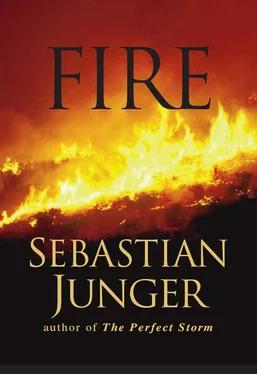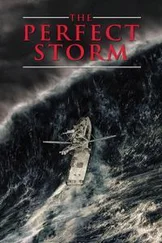In the Northern Rockies wildfire is usually started by lightning. Any lightning strike that reaches the ground can cause an explosion, but only lightning with a continuous current can start fires. In the Northern Rockies it has been estimated that one lightning stroke in twenty-five is a cloud-to-ground stroke capable of starting a fire. The inital bolt from cloud to ground moves relatively slowly, at one two-thousandths the speed of light, but it returns at one-tenth the speed of light and heats the gases inside it to fifty thousand degrees Fahrenheit. That much energy hitting a tree instantly raises it way past the ignition point, and often the tree just explodes. Flaming chunks of wood are hurled into the forest, and if the conditions are right for fire, the flames take hold.
Fire is a chemical reaction that releases energy in the form of light and heat. In the case of a wood fire, the energy was originally derived from the sun during photosynthesis and stored in the plant as cellulose and lignin. Heat—from a fire that is already burning or from a lightning strike—converts the cellulose and lignin into flammable gases, which are driven out of the wood and combined with oxygen in a process called rapid oxidation. At the base of any flame there is a clear band of superheated gases that have not yet ignited, a thin blue area of ignited gases, and a broad yellow band of incandescent carbon particles. The heat generated by this process continues to drive flammable gases out of more fuels, which burn and generate more heat. The heat also drives out moisture that might impede combustion. As long as there is sufficient air, fuel, and heat to ignite more fuel, the fire will keep advancing. As long as the fire keeps advancing, the fire triangle remains stable and continues to create the conditions necessary for fire.
A plume-dominated fire, more commonly known as a fire storm, is this same cycle writ large. In this case the three legs of the fire triangle not only provide the conditions for fire but amplify one another in an apocalyptic feedback loop—a “synergistic phenomenon of extreme burning characteristics,” as it is known. As in all fires, heat generates wind, which makes the fuels burn hotter, generating more wind. If a high fuel load is introduced into this loop, a convection cell of smoke and gases can be set in motion that overrides the local wind patterns. During World War II Allied bombers intentionally started fire storms in the German cities of Hamburg and Dresden; in that case the high fuel load was densely packed houses ignited by thousands of tons of ordinance. Once the convection engine has started, it is nearly impossible to stop. Entire stands of trees torch as one. Tornadoes twist through the interior of the storm. Superheated fuels appear to combust spontaneously in a phenomenon called “area ignition.” Such a fire can rip through well over one hundred thousand acres of timber in one day.
Another sort of apocalypse, equally destructive, is the running crown fire. Crown fires occur when flames climb so-called ladder fuels into the treetops and are swept along by high winds. In 1967 a running crown fire crossed the Idaho panhandle on a four-mile front that incinerated sixteen miles of timber in nine hours. The Sundance fire, as it was called, was calculated to have burned at rates of up to 22,500 British thermal units per square foot per second. By comparison, 500 Btu is the outer limit of what humans can control; 1,000 Btu describes potential fire storm conditions. The Sundance fire was estimated to release the energy equivalent of a twenty-kiloton Hiroshima type of bomb exploding every ten minutes.
Not all big fires are fire storms, of course, and not all fire storms are big. The Steep Creek blowup on the Lowman fire had the physical characteristics of a fire storm but was limited in area; the Foothills fire developed several convective columns over heavy timber but went on to become a wind-driven fire that ripped through two hundred thousand acres in two days, making it one of the biggest fire runs ever. In the Northern Rockies there are a host of winds that push fire: jet stream winds that drop down over mountainous areas; chinook winds that plunge downslope because of an air pressure differential; cold fronts that move in for twenty-four hours at a time; and, of course, unstable air associated with the fire itself. Unstable air rises and falls with the atmospheric conditions, whistling up canyons, sheering over ridges, bending around solitary trees or boulders to start whirls up to four thousand feet high. Any of those winds, in the wrong situation, could cause a blowup and kill people. That was why Mike Rieser was on a ridgetop watching the clouds rather than down in some canyon fighting the fire.
Hotshots have been known to complain that overhead—the men and women who risk other people’s lives—do not do enough. Not only that, but hotshots believe that many overhead have never really fought fire and therefore can’t be trusted to make life-and-death decisions. Sometimes that is true; there are the inevitable instances of ’shot crews simply saying, “No, we won’t go in that canyon,” or, “No, we won’t try to hold this ridge.” More often, however, the members of a command team, like Rieser, have worked their way up from grunt-hood to positions of authority over the course of years, if not decades. Rieser has fought fire for nearly twenty years and had two extremely close calls (that he told me about). Once he and his crew fell asleep after cutting line all night and were almost burned over; another time he was caught in a chaparral fire outside Los Angeles. Chaparral fires are extremely volatile because, invariably, the fuels are bone dry, the terrain is steep, and the winds are terrible: Santa Anas that hit seventy miles an hour for days on end. It was in 1979, and Rieser was on a type two crew that, he says, had violated just about every watch out rule in the book.
“We were backfiring off a road two-thirds the way up a ridge,” he said. “We couldn’t get a good burn because of a marine air intrusion. We double-shifted into the next day and got a dominating Santa Ana wind, and the fire just blew up. We were right in a canyon, it was acting like a natural chimney, and the flame front was on us in about ten minutes.”
In those ten minutes the crew managed to jump onto a tanker truck and make it to a marginally safe area at the intersection of two dirt roads, not big enough to qualify as a legitimate safe area but better than nothing. They parked the truck and crouched down between it and a road cut. The crew were so rattled that they were reading the Spanish side of their fire shelter instructions, not understanding a word. While the rest of the crew were trying to figure out their instructions, the fire went through.
“It was so loud that we couldn’t even shout to each other,” Rieser said. “It was not intolerably hot; the smoke was what was hard. We called in an air tanker and heard it make the drop about half a mile away; that was scary because we realized the smoke was so thick they didn’t even know where we were. It was an out-of-control situation, and our fate was in the hands of people who had made very questionable decisions. That was the turning point for me. I’ve been on worse fires, but I always pull the crews out before it gets bad. They say, ‘Aw, we could’ve held that,’ and then they watch it boil over.”
In 1871 a forest fire swept over the town of Peshtigo, Wisconsin, and killed more than fifteen hundred people. A fire in Chicago killed another three hundred people on the same day and is known as the Great Chicago Fire; the Peshtigo tragedy isn’t known as anything. Fires come in waves or complexes, and the Peshtigo and Chicago tragedies were part of a wide swath of fires that year that extended from Ohio to the High Plains. Since 1900 well over seven hundred people—it’s not known exactly how many—have died on wildfires in America, the vast majority of them men who were employed or had volunteered to fight the fires. The mass tragedies are mostly from the early days when there were no radios, no fire shelters, no aircraft, and no accurate weather forecasts. The next big fire complex after Peshtigo was the Big Blowup of 1910. Eighty-five men died battling the fires, some of them because they panicked and committed suicide after the fire lines were overrun. State troopers played taps over the caskets and buried them in mass graves in the hills. It was just this side of war.
Читать дальше












